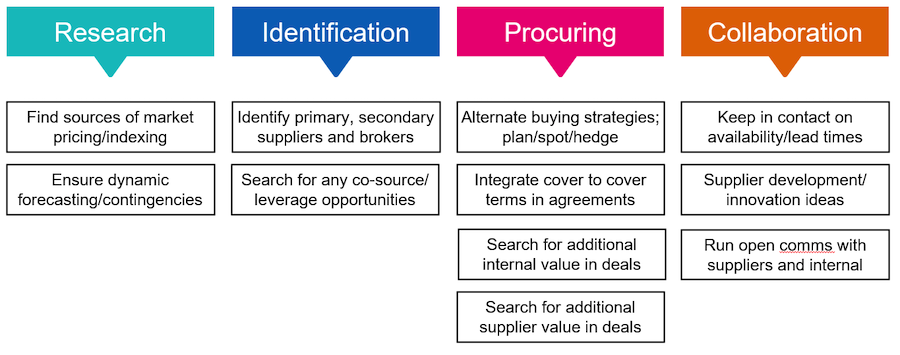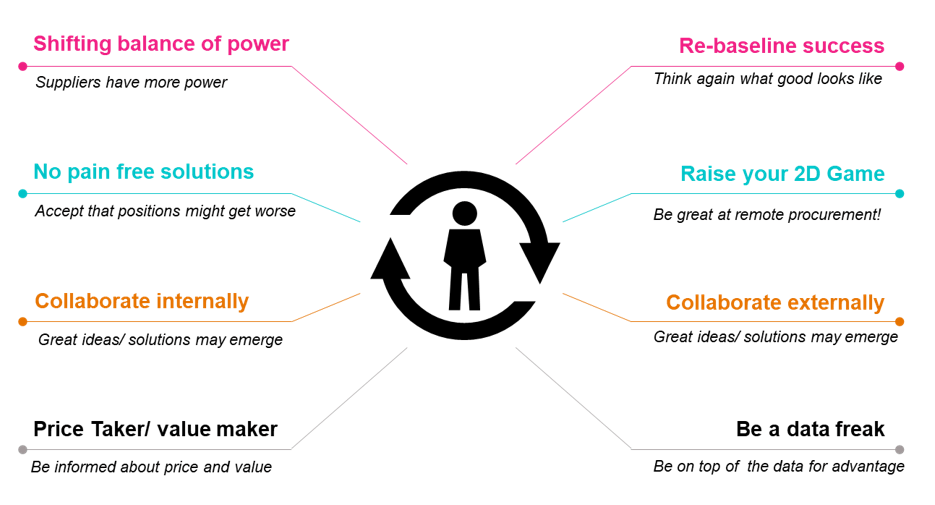How Procurement Can Respond to Inflation and Volatility
Inflation is a word that has been on the minds of every procurement team in 2021. We are seeing a sustained period of supply shortages and price volatility of the kind that most commercial professionals will not have experienced in their working lives. In one way or another, it is having an impact on virtually every business.
The causes and the severity of inflation are complex. Much of the origin comes back to either COVID or climate impacting the availability of raw materials, people and infrastructure. Thereafter, we can layer on compounding events like the Suez Canal blockage or Chinese port closures, as well as sudden and rapid shifts in demand for glass, plastics and corrugate, for example. And then there are semiconductors, of course, reflecting where a fast-growing global trend and just-in-time supply chain meet constrained supply.
While the causes are complex, the outcomes are common – availability drops and prices increase. Service levels are often affected too. For example, major players in the logistics market are scaling back service levels and increasing prices. Why is this? Because they have to and they can.
The same is true of shipping channels where prices are in some cases 10 times higher than in 2019 for an on-time delivery metric (at 38%) that is half as good as 2019. And then there are semiconductors, where some lead times have reached over a year.
For a professional whose focus is buying, a sellers’ market is not where procurement wants to be. For many procurement professionals, it is not a place that they have been to before.
So, is the only option being held captive to price? Well, you may need to accept that your year-on-year savings target may suffer, so it is time to think differently about how to create value.
Get in the Right Mindset
First of all, it is time to face the facts. Inflation and shortages are here, as are price increases. If you do what you have always done, you will not get the same outcome. If you procrastinate or hold off hoping for improvement, right now, you will not get the same outcome.
Buying in inflationary markets is different. But it also enables you to focus on new ways of creating value. It needs you to be on your game and it needs the best of you as a supply market expert and a commercial architect. You will be faced with some of the following:
- Higher prices
- Unfavorable quality or service levels
- Slow lead times
- No supply
- Force majeure or unforeseeable circumstances
Here are three tips to position yourself to get the best out of the current markets by looking at your organization, your supply markets, and of course, yourself.
1. Business Focus
How good is your data? How connected are you to your customers? Are you connected into product and commercial teams? These are all going to be areas of focus when tackling inflation to stabilize, reduce or eliminate demand or to embed the effects into manufacturing and commercial strategy.
A good place to start is undertaking a risk assessment to map what you buy and the contracts you have to current market volatility and forecasts. You cannot do everything, so focus on critical goods and services and supply chains. Armed with this, identify the key business owners and form a crisis team to figure out how to bake the reality into the business.
The tactics you are able to use will depend upon the specific market dynamics. But consider the following:

Understanding your internal position gives you options. There are likely things that can be done to reduce exposure. Further, where price and availability occur, other operational and commercial contingencies can be enacted to reduce waste, risk and cost exposure.
Your business will thank you for it.
2. Market Focus
Suppliers may look like the largest part of the problem, but they are also going to be a large part of the solution. First and foremost, if you have to become a price taker, become an informed price taker. And that means navigating market data.
Do you know if you are absorbing market-wide inflationary costs or if you are paying more because you are working with a certain supplier? Banging the table and asking for a discount probably is not going to work.
But getting ahead on data is going to make you more informed when striking deals. What is the market rate and how is it trending? If you cannot answer this then you are uninformed and at the mercy of a sellers’ market.
Getting ahead of the game is going to mean understanding the market and your position in it, as well as tirelessly searching for the best deal or alternate ways of creating value. It will not be easy, but it will be worth it. Consider these tactics:

As a procurement professional you are the expert on markets. By deploying some of the tactics above you will identify yourself as a problem solver, someone who understands business needs and uses creative supply solutions to solve them. Now that is better than being known as the process and price person, isn’t it?
We all want to move up the value chain after all.
3. Focus On You
Unless what happened above is your regular day-to-day or you are used to buying in inflationary markets, chances are that you will try and learn some new things in the coming weeks and months. So, what are the most important things for you personally to remember when thinking about mindset, business and market focus?

Shortages and inflation are big business problems. Even if you cannot solve them completely, there is value to be made, success to be had and an opportunity to reposition your impact.
Let’s not pretend that you are going to outperform the market, but you might be able to get the best that the market can offer while minimizing further operational or commercial waste in your business. That might be what success looks like.
But you will only be successful if you proactively make the changes that will allow you to do so.
The Outlook
Inflation and shortages are not going anywhere fast. In a normal market, we might be seeing a way through it by now, but the compounding factors keep coming. The mitigating factors like onshoring and automation, which may spark deflation in 2023/2024 are either mid-term plays or suffering from delays, skill shortages and inflation.
So go forth, make the best of it and polish up your skillset at the same time. You might just come out on the other side stronger, better and a little further up the value chain.








